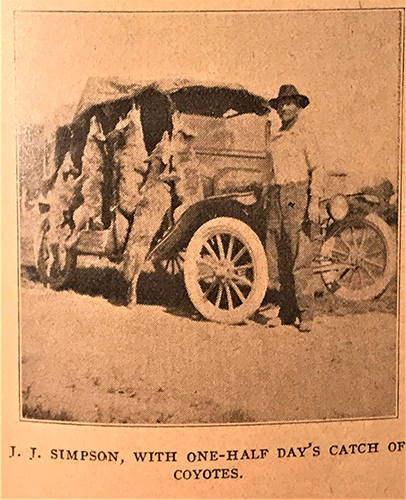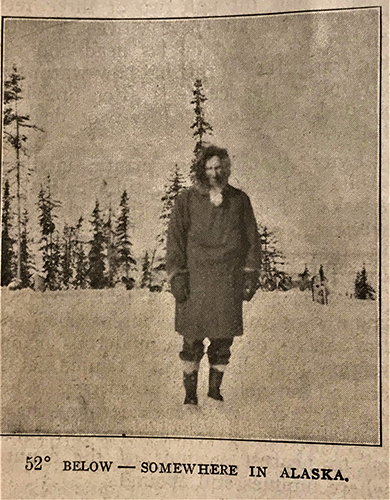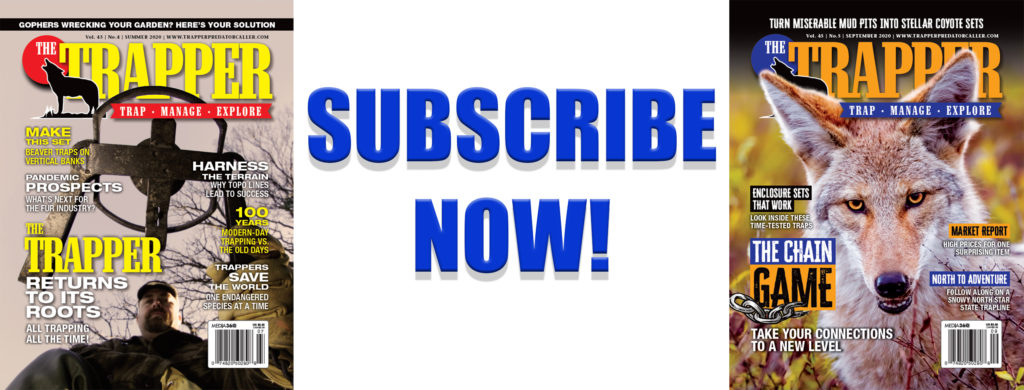What has changed in 100 years of trapping?
By Toby L. Walrath
We trappers today think we’ve got troubles with foul weather, wary critters and anti-trapping/hunting crowds. We see conservation and education as paramount to the future of our lifestyle, and when we aren’t hyper focused on the latest fur prices, we’re ogling over the latest products and methods. The latter of which we turn to magazines for, like the one you’re holding in your hands right now.

Skilled trappers capable of catching large numbers of animals were highly sought after to employ at the turn of the century. Credit: Utley, H.A. (1922). A Reply From Lake County Oregon. Hunter Trader Trapper, February, 1922, p. 29
One hundred twenty years ago the first issue of the Hunter Trader Trapper (HTT) was published and stayed in print until 1938. Recognized as the first truly national publication about hunting, trapping and camp craft, it held the words and stories of average folks who knew their craft and wanted to share. So, here we are more than 100 years later reading articles written by average guys who know their craft and want to share. I recently read several issues from as far back as 1918. So what has changed and what has stayed the same?
The very first page of the February 1918 issue (that cost 15 cents by the way) features a full page advertisement by G. Gaudig & Blum, INC. promising “Highest Prices-Fair Assortment-Prompt Returns.” The second page held an ad for a famous canoe company (that’s still in business today), a shotgun manufacturer (also still in business) and another ad from a trapping company wanting furs. By the time I reached page 14 there were 27 fur-buying advertisements. I guess things were going pretty good with the fur trade at that time.
The first article in that February 1918 issue was written by a man named J. W. Stolle, titled “Trapping in Alaska,” complete with photos of a remote cabin, a gold panner and a warmly dressed man standing in a snow-covered forest above a caption that read “52° BELOW SOMEWHERE IN ALASKA.”
It was the last frontier way back then and every trapper in the lower 48 had probably dreamed about going there a time or two. Now, here we are 100 years later and still digging deep into the words of trappers who tell tales of wild places and extreme weather in — you guessed it — The Last Frontier. I wonder how many times I’ve read stories about trapping the Alaska Interior with the same enthusiasm for the subject matter as the trappers with those earliest issues in their hands.
More articles gave accounts of trapping in “the hills and hollers” and the adventures of trappers in their quest for more furs along rivers and remote backcountry camps. One article had the head-turning title of “Some Hints on Judging Distance for that Long Range Shot,” with the byline T.T. Pierce. I wonder how many articles have been written and continue to be written with variations of that very topic?
The monthly columns included a variety of things like “Wood Craft,” with the intriguing tagline: “If making a trap or an arrow and bow, a bridge or a bed, or a camp bungalow, and many more things H-T-T readers do, this woodcraft department will interest you!” That sort of catchphrase would be laughable these days. But at that time it was first rate marketing style.
The article published in the woodcraft department was about how to make footwear, braid rawhide, make a skunk deadfall trap and how to construct a box trap. The desire to make things hasn’t changed much, at least for me, and I was pulled into this how-to section just like I imagine the trappers of that time were. Who among the readers of The Trapper wouldn’t look at a diagram of how to weave and build a whip? And I can guarantee that my 8-year-old son will be in the backyard trying to build a skunk trap within three minutes of reading about how they did it in 1918.
We often talk and read about things like how important it is to stick together as hunters and trappers. We find ourselves longing for the old days when things were better and there weren’t any anti-everything’s lurking about. That’s why I was shocked to see these words written by M.C. Townsend in a feature-length article in which he wrote of the magazine’s important subject matter:
“It is the medium for the exchange of ideas of all classes of hunters and is doing great good in bringing them together. Brother hunter, we need cooperation to secure wise legislation or the joy of the hunt, the love of the trail, will soon be a thing of the past.”
These words were published more than 100 years ago. This piece was followed by an article about conservation efforts in Mississippi by fishermen, at a time when people began asking how long the big river could sustain commercial harvests. By now all of this should sound familiar to any sportsman who reads magazines about modern-day outdoor pursuits.
E.J. Dailey
One of my favorite old-time trappers is E.J. Dailey, who wrote about his trapping adventures in a way that captivated readers with simple prose. The Adirondack trapper from New York State would go on to become a legend in his own time. I remember local people were still talking about his accomplishments when I was a teenager running traplines in the same areas he had decades before me.

One hundred years ago photos with trappers standing next to their catch were as popular as they are today. Credit: Dailey, E.J. (1918). Modern Traps and Trapping. Hunter Trader Trapper, February, 1918, p. 79
His article, “Modern Traps and Trapping” started off with these words:
“Being a reader of nearly all hunting and trapping magazines I have noticed that while modern guns and hunting are discussed thoroughly, yet rarely do I see anything in regard to any advancement in steel traps or trapping, so it seems to be up to me to start the ball rolling along these lines.”
Dailey went on to write about the newest modern traps that included the double jaw victor made by the Oneida Community Company, and high grip traps made by the Triumph company. Dailey wrote that, “As reports came that fur was going to be high I decided to dispose of some ordinary traps, which I had used for some time and get some up-to-date goods.” I can’t help but read those words and smile because I have found myself in this exact situation; hearing reports of high prices and buying new traps with modern features that I thought would improve my catch.
Every good adventure story needs three things: an unknown wild place, details about the hardship and success, and a captivating writer to deliver the goods. Dailey’s story about “The Trapping of Big Huckleberry Swamp” had all of the necessary parts, and began with a perfect introduction:
“Big Huckleberry Swamp consists of more than a thousand acres of bog slash and swale, a more dismal spot one could scarce imagine. It is located in the lower St. Lawrence Valley, and the ownership would be hard to prove.”
There it is; an introduction to the wild place complete with the foreshadowing of the hardships to come. But midway through the piece Dailey wrote:
“The morning glow gave promise of an ideal Indian summer day, and after a hasty breakfast of brown bread and coffee, I packed a lunch, not forgetting the homemade chocolate fudge, of which I eat a great lot during my wanderings over various trapping sections.”
The feature photo shows Dailey placing a coffee pot on a makeshift fire ring in front of an A-frame tarp pitched with a single pole in front, and guylines pulled tight against wood stakes. A double longspring trap hangs conspicuously just behind his shoulder. E.J. Dailey knew the importance of good photos to support his stories, and this one included a raccoon sticking its head out from a den tree and a dead fox with its head laid respectfully on a stump. And so did many other magazine writers of that day.
Unique Characters Abound
Like any trapper I enjoy reading the adventure stories of others from their own perspective, but I also like a good story about people who wouldn’t likely see a reason for anyone to be interested in them. Over the years I have written about men and women who spend their time hunting and trapping, and invariably they are surprised to learn that thousands of people would love to read about them. Such was the case in an article written by H.A. Utley about a man living in Oregon who trapped on “government land that is open for entry.” Mr. Simpson is introduced as “a married man but unfortunately has no children to help him with his trapping, but his wife is one of the best trappers in the state.”

Remote, wild places like Interior Alaska and Northern Canada have long been a part of the allure of the trapline. Credit: Stolle, J.W. (1918) Trapping In Alaska, Hunter Trader Trapper, February, 1918, p. 22
Mr. Simpson and his wife trapped more than 100 coyotes each month during the season. His wife would run one line and he would run the other, meeting back at camp each night to handle the pelts. Stories about people like Mr. Simpson and his wife still intrigue hunters and trappers today. The story about the Simpsons was complete with photos of coyotes lined up along his Ford car showing a half of a day’s catch, and bobcats in rock outcroppings. Mr. Simpson even had a bobcat that he trapped wearing a collar on a chain sitting next to his dogs. Talk about a good story!
After digging into more issues of the old publication, I found stories of traplines from all over the country, the methods trappers and hunters used to increase their catches, and the woes of high water and heavy snows. The similarities to the articles we read today are incredible.
Gear & Technology
The advertisements were similar to those we see today too, selling boots and clothes, tanneries and fur garment makers plugged their services and urged readers to send for a catalog. One thing that was different was the absence of lure advertisements. Somewhere in the back I found just three small ads for baits and scents. The lure industry was in its infancy back then, starting with just a few lines for each lure maker. Compared to all of the lures available today, that is one area that has certainly changed a lot, and for the better.
Trappers are still trying to figure out how to keep our traps working when the weather gets foul. Fur prices still rise and fall like the ocean tides between one species or another, and new traps and products keep driving an innovative industry. We trappers still spend a lot of time digging holes and wading through swamps, too. We still scratch our heads and wonder how animals with brains the size of golf balls can outsmart us, and then we contrive ways to outsmart them right back.
When writing about trapping foxes, E.J. Dailey wrote that he covered his trap well with leaves. Today, we would sift dry waxed dirt or add a freeze-proof ingredient to thwart off the weather. Volumes were written back then about the advantage of buying a car or a motorcycle to replace using horses or working longlines on foot. We don’t read much about longlines on foot anymore — or using horses. So, a few more things have changed with modern technology.
The Call of the Trapline
But, the trapper’s lifestyle still remains in contrast to the pull of society. All of the things that made trapping challenging and enjoyable 100 years ago — are exactly the same things that keep us modern-day trappers pursuing all that the outdoors have to offer.
Perhaps our fellow trapper George Theodore Freihofer said it best when he wrote these words: “’Neath sheltering bough and frosty twig the bonny muskrat hides.” It’s been 102 years since he wrote those words. After standing next to a muddy, brush-lined pond he took a photograph to share with other trappers, probably the only people in society who could really appreciate such a scene. As I peered into that photo printed on the pages of a magazine six decades before I was born, I realized that many things have changed between his time and mine. But the allure of natural places and fascination with wild animals hasn’t changed at all, and neither has the need to keep trying and sharing ideas with other like-minded individuals with society at our backs.

